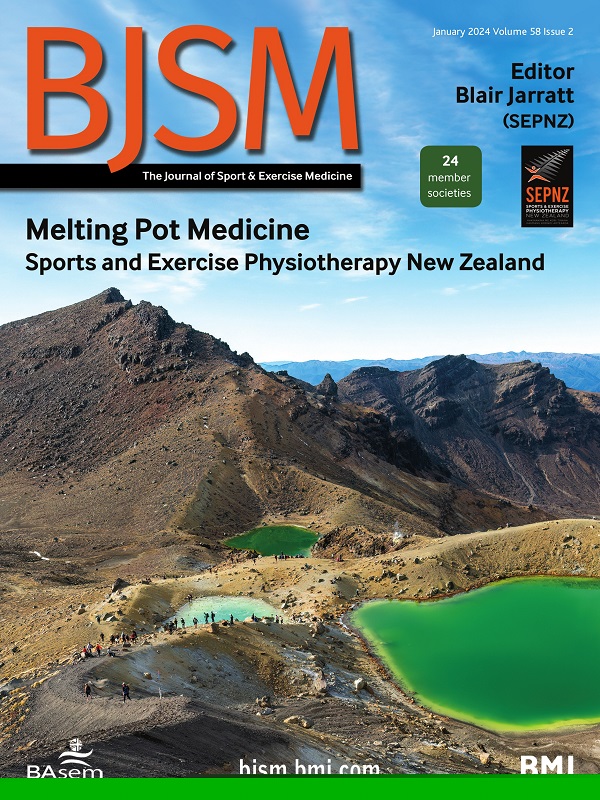Running is acceptable and efficacious in adults with non-specific chronic low back pain: the ASTEROID randomised controlled trial
IF 11.6
1区 医学
Q1 SPORT SCIENCES
引用次数: 0
Abstract
Objectives Running is one of the most accessible forms of exercise, yet its suitability for adults with chronic low back pain (LBP) is unknown. This study assessed the efficacy and acceptability of running in adults with chronic LBP. Methods This two-arm parallel (1:1) individually randomised controlled trial allocated 40 participants (mean (SD) age: 33 (6) years, female: 50%) with non-specific chronic LBP to a 12-week intervention or waitlist control. The intervention was a progressive run–walk interval programme comprising three 30-min sessions per week that were digitally delivered and remotely supported by an exercise physiologist. Efficacy outcomes were self-reported pain intensity (100-point visual analogue scale) and disability (Oswestry Disability Index). Acceptability outcomes were attrition, adherence and adverse events. Results At 12-week follow-up, the intervention improved average pain intensity (mean net difference (95% CI): −15.30 (–25.33, –5.27) points, p=0.003), current pain intensity (−19.35 (–32.01, –6.69) points, p=0.003) and disability (−5.20 (–10.12, –0.24) points, P=0.038), compared with control. There was no attrition, and mean (SD) training adherence was 70% (20%; ie, 2.1 of 3 sessions per week). Nine non-serious adverse events deemed likely study-related were reported (lower limb injury/pain: n=7, syncope associated with an underlying condition: n=1, LBP: n=1). Conclusions A run–walk programme was considered an acceptable intervention by the participants to improve the pain intensity and disability in individuals aged 18–45 years with non-specific chronic LBP when compared with the control. An individualised and conservative run–walk programme should be considered a suitable form of physical activity for adults with chronic LBP. Trial registration number Australian New Zealand Clinical Trials Registry: ACTRN12622001276741. Registered on 29 September 2022. Data are available upon reasonable request. The datasets used and analysed during the current study are available from the corresponding author on reasonable request.跑步对患有非特异性慢性腰背痛的成人既可接受又有效:ASTEROID 随机对照试验
目的 跑步是最容易接受的运动方式之一,但它是否适合慢性腰背痛(LBP)成人患者还不得而知。本研究评估了跑步对慢性腰背痛成人患者的疗效和可接受性。方法 这项双臂平行(1:1)单独随机对照试验将 40 名患有非特异性慢性腰背痛的参与者(平均(标清)年龄:33(6)岁,女性:50%)分配到为期 12 周的干预或等待名单对照组。干预措施是一项渐进式跑步-步行间歇训练计划,每周三次,每次 30 分钟,由一名运动生理学家以数字方式提供远程支持。疗效结果为自我报告的疼痛强度(100 分视觉模拟量表)和残疾程度(Oswestry 残疾指数)。可接受性结果为自然减员、依从性和不良事件。结果 在 12 周的随访中,干预改善了平均疼痛强度(平均净差异(95% CI):-15.30(-25.30)):-15.30(-25.33,-5.27)分,P=0.003)、当前疼痛强度(-19.35(-32.01,-6.69)分,P=0.003)和残疾程度(-5.20(-10.12,-0.24)分,P=0.038)。没有自然减员,平均(标度)训练坚持率为 70%(20%;即每周 3 次训练中的 2.1 次)。有 9 例非严重不良事件被认为可能与研究有关(下肢损伤/疼痛:7 例;与潜在疾病相关的晕厥:1 例;腰痛:1 例)。结论 与对照组相比,参与者认为跑步-步行计划是一项可接受的干预措施,可改善 18-45 岁非特异性慢性枸杞痛患者的疼痛强度和残疾状况。对于患有慢性腰椎间盘突出症的成年人来说,个性化和保守的跑步-步行计划应被视为一种合适的体育锻炼方式。试验注册号:澳大利亚-新西兰临床试验注册中心:ACTRN12622001276741。注册日期:2022 年 9 月 29 日。如有合理要求,可提供相关数据。本研究中使用和分析的数据集可向通讯作者索取。
本文章由计算机程序翻译,如有差异,请以英文原文为准。
求助全文
约1分钟内获得全文
求助全文
来源期刊
CiteScore
27.10
自引率
4.90%
发文量
217
审稿时长
3-8 weeks
期刊介绍:
The British Journal of Sports Medicine (BJSM) is a dynamic platform that presents groundbreaking research, thought-provoking reviews, and meaningful discussions on sport and exercise medicine. Our focus encompasses various clinically-relevant aspects such as physiotherapy, physical therapy, and rehabilitation. With an aim to foster innovation, education, and knowledge translation, we strive to bridge the gap between research and practical implementation in the field. Our multi-media approach, including web, print, video, and audio resources, along with our active presence on social media, connects a global community of healthcare professionals dedicated to treating active individuals.

 求助内容:
求助内容: 应助结果提醒方式:
应助结果提醒方式:


